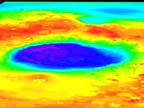
CATASTROPHISM
AND ANCIENT HISTORY
VOLUME VII Part 1
January 1985
A Journal Of Interdisciplinary
Study
Marvin Arnold Luckerman
Executive Editor
SCARS OF MARS
Continued-Part 2


The Scars of Mars
DONALD W. PATTEN
V. Asteroids and Martian Craters Compared
In 1983 a total of 2736 asteroids were identified and logged.[6] These were, of course, only the largest. Based on the pitlets of some asteroids and on Deimos and Phobos, Mars' two trabants (satellites), there must have been considerable debris too small to see in telescopes or to record in telescope photography.
In Table III we find 3068 20-mile or larger craters in the Martian Hemisphere of Craters and only 237 in the Opposite Hemisphere. Let us assume that in previous and subsequent time, another 237 struck the Hemisphere of Craters. This leaves a count of 2831 which may be attributed to Astra, plus any which have been covered or masked by subsequent lava outflows, erosion, or by subsequent watery or icy catastrophes, etc.
It was found that the sizes of the largest current asteroids and the largest impact asteroids were commensurate. Now we also find that the number of identified asteroids (2736) and the number of Astra 20-mile craters (2831) is also commensurate. Perhaps this is because we can telescopically and photographically record, at our distances of the asteroids, only those down to about 15 or 20 miles in diameter At any rate, we observe a commensurability in both size and in number, whether this be coincidence or not.
We have examined the physical geography of the Hemisphere of Craters in some depth, but that is only half of Mars and is that also only half of the catastrophic scenario for Mars? It appears that the Opposite Hemisphere also has a strong tale of catastrophic woe.
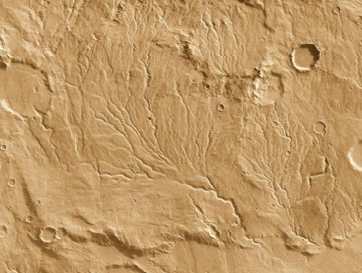
VI. Location of the Bulge Region on Mars
Figure 7 illustrates the Opposite Hemisphere of Mars. Three kinds of phenomena are brought to attention:
1. Bulging
2. Rifting
3. Volcanism
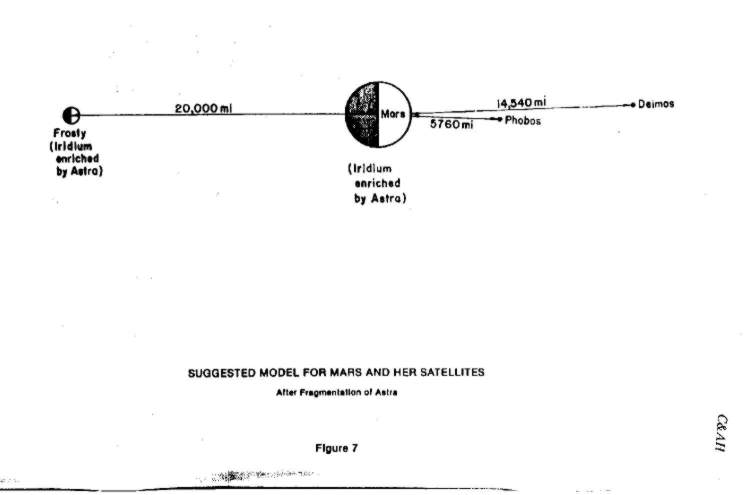
Most planets are not perfect spheres. Earth, for instance, is an oblate spheroid - fatter around the equator and flattened at the poles; this is due to a compromise between centrifugal force and gravity. The Moon has a lump or bulge on one side. Mars has both, for Mars also rotates like the Earth, and at a similar rate (one day of rotation is 24 hours 37 minutes). Mars is an oblate spheroid with a bulge region. The bulge region is known as the Tharsis Bulge (see Figure 9).
The Tharsis Bulge is a large shield or uplift area in the Opposite Hemisphere. It is approximately 6 1/2 miles high in the center relative to the general crust and on that small planet it is about 3000 miles in diameter; it crosses 90 degrees of latitude. The central core area of the Tharsis Bulge is very close to the equator and around 105 degrees West Longitude.
The Hellas Crater is centered around 295 degrees West Longitude and 45 degrees South Latitude. Tharsis, a bulge zone, is almost 180 degrees opposite to Hellas Planitia, the lava region where Hellas hit Mars. To be precise, it is 190 degrees to the west (or 170 degrees to the east). We suggest that the massive Hellas strike on one side of Mars caused the bulge on the opposite side. The Hellas impact asteroid, the core of Astra, may have been between 850 and 900 miles in diameter, and it probably struck Mars at a speed of 6000 miles per hour, which is 100 miles per minute.
Based on the fact that the center of the Hemisphere of Craters is at 45 degrees South Latitude, it is concluded that Astra approached Mars to the south of the ecliptic plane, and perhaps up to 1000 miles to the south at the moment of fragmentation. Also, from other data yet to be presented, it would seem that Astra approached Mars on the sunward side (of Mars); probably Astra was moving toward aphelion and Mars probably had just passed aphelion about 30 days previously and was beginning its motion toward perihelion.
The angle formed between Hellas Planitia, the smooth, magma-covered region engulfing the Hellas Crater, and the Tharsis Bulge suggests the trajectory of Hellas as it approached Mars. Since Hellas is about 10 degrees east of the center of the Hemisphere of Craters, it is logical to conclude that Hellas hit Mars about 20 degrees, or 700 miles off center. And center is described s the subpoint under the fragmentation. Astra and the fragment Hellas careened toward Mars slightly from the south of the ecliptic (orbital) plane of Mars. Hence the line between Hellas and Tharsis proceeds in a northerly trajectory from if Hellas to Tharsis; this is the direction of the pressure waves inside Mars.
Thirty minutes prior to the impact of the Impact Asteroids (and at the moment of fragmentation), Mars must have been writhing in a sudden tidal surge. This tidal surge continued without significant abatement during the 30 minutes that the Impact Asteroids (and to a lesser extent the Current Asteroids) were approaching. The three largest asteroids Hellas, Isidis, and Argyre broke open the crust of Mars so wide that massive "bleeding" extrusions of magma resulted.
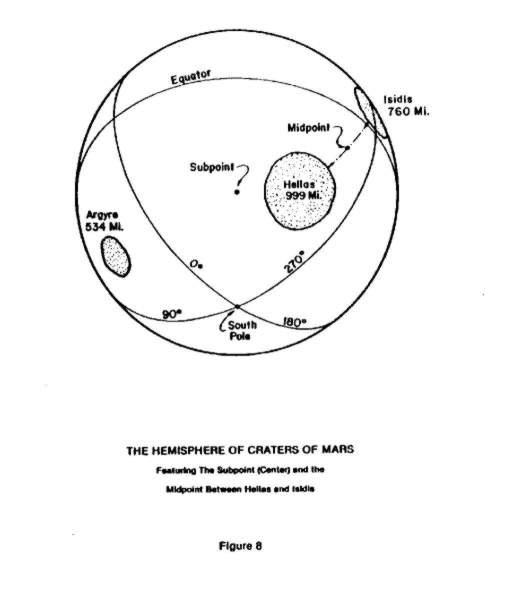
And within a 25-minute period, in addition to the massive, surging tides of internal magma, Mars received scattershot blasts by about 2800 impact asteroids which were over 15 miles in diameter, plus many more of smaller diameter. But above all, the impact of Hellas, approximately 38 percent of Astra's original mass, must have devastated the innards of Mars. So immense were the pressure waves, we believe, that the Tharsis Bulge resulted as a single mechanism to relieve the sudden thrust. Its uplift required just a few minutes.
The pressure waves from the Hellas impact are estimated to have traveled within Mars at a rate of 150 miles per minute. The diameter of Mars was about 4200 miles (and growing by the accretion of Astra materials). In about 28 or 29 minutes the Hellas pressure waves were reaching the opposite side of Mars on the inside of its crust. We propose that these pressure waves caused the uplift in the Opposite Hemisphere, in the equatorial region about 170 degrees from the Hellas impact. Figure 8 illustrates this effect.
Thus we propose that the time lapse between Astra's fragmentation and the uplifting of the Tharsis Bulge was no less than 55 minutes and no more than 75 minutes. From fragmentation it took the Hellas Impact Asteroid about 30 minutes to arrive at Mars' crust and it required another 28 minutes for shock waves to arrive on the opposite side. Perhaps another 10 to 15 minutes were needed for the uplifting process hence 75 minutes in all from fragmentation to Tharsis.
There is another bulge zone on Mars. The Elysian Bulge is located in the region 230 degrees West Longitude and 40 degrees North Latitude. This region seems to be at the opposite end of the trajectory formed by the Isidis Impact Asteroid, which body came within a hundred miles of missing Mars. Isidis is on the rim of the Hemisphere of Craters. The Elysian Bulge is just opposite that impact zone.
A prominent opinion of the relationships between the Tharsis and Elysian bulges, and the Valles Marineris (see Section VII, below) and the general geological history of Mars comes from Moore and Hunt: [7]
Extending eastward from Tharsis is an immense canyon system, Valles

Marineris, while radiating outward from it are large arrays of tensional
faults (graben); both are presumably related to the formation of Tharsis
itself. North of the canyons are numerous fascinating outflow channels
which appear to have been produced during a period of catastrophic
flooding, between 3,500 and 3,000 million years ago. . .
While Mars' early history is not well understood, it is likely that the
resurfacing of the northern hemisphere took place very early on, perhaps
as long as 4,000,000 million years ago. Many scientists believed this was in
some way connected with the formation of Mars' inner core
region
[ Emphasis added.]
In contrast with what "many scientists believed," the conclusion of this essay is that the later period of catastrophic flooding on Mars was more like 5000 than 5,000,000,000 years ago. And the timing of the Astra fragmentation and the Hellas Impact Asteroid event was between 5000 and 15,000 years ago not more. Contradicting or substantiating facts, such as dust drift accumulations in Mars' craters and other data, will undoubtedly clarify the matter in due time.
Figure 2 illustrates Mars' general scene prior to the fragmenting of Astra, as does Figure 1 in an orbital perspective. It is suspected, however, that Mars had a small, icy or Frosty" satellite (not shown).
After Astra's fragmentation, Mars acquired two small asteroid-like satellites, Deimos and Phobos. And perhaps Mars acquired, temporarily, a ring of lesser asteroidal debris, judging by the pitlets on Deimos and Phobos.
At the time of Astra's fragmentation, it is suspected that both the surface of Mars and "Frosty" were enriched with iridium, assuming iridium to have been abundant as a trace element in Astra's composition. A further catastrophe ensued later (not discussed in this paper), wherein Frosty also fragmented, depositing ice and water upon the surface of Mars, among other places. [8]
Figure 9 illustrates our understanding of Mars' scenery subsequent to Astra's fragmentation.
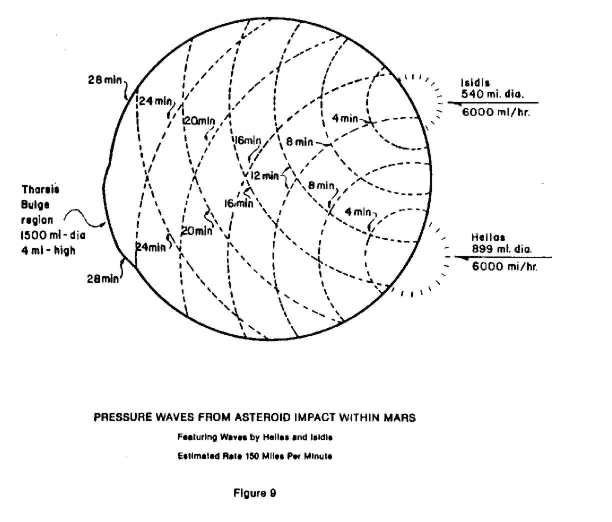
II. Location of the Rifting Region on Mars
Noctis Labyrinthus: Between the Tharsis volcanoes and the Valles Marineris is a complex system of fractures resulting from an extension of the crust. The area has the highest elevation of the region and is believed to be the apex of uplift. The smoother Noctis Lacus area has wind sculptured features, to the west of which is a complex system of criss crossing fractures. [9]
Chaotic terrain exists on Mars just to the east of the Tharsis Bulge. It includes a maze of short, interconnected canyons which has the name Noctis Labyrinthus. This region has what appear to be a series of uplifted blocks or sections, and this also indicates the impact of the Hellas impact Asteroid on the opposite side: [10]
Visible even on long-distance images of Mars is the great canyon system, which straddles the globe just south of the equator between longitudes 30° and 110° W. Called Valles Marineris, this 4,000 km-long network begins on the east side of the Tharsis Bulge and ends in an immense region of chaotic terrain between Chruse Planitia and Margaritifer Sinus. At its deepest it is some 7 km deep and individual canyons are up to 200 km in width. In the impressive central section, where there are three roughly parallel, interconnecting rifts, the total width is 700 km.
In this thesis Mars acquired about 70 percent of Astra's mass as it gathered that much of the volume of asteroidal debris. Hellas alone was as much as 38 percent of the mass. Mars new mass is between 1 and 1 1/2 percent greater than its former mass: for that kind of a sudden growth the thin crust needed to find some accommodation for expansion. The crust, parallel to he equator, split open and expanded, just as a tear in a pantleg will occur, due to a new, sudden, nternal stress such as the abruptly added weight of the wearer.
Our calculations suggest
that, over the next century or two, the diameter of Mars increased from
about 4199 to 4222 miles, the Valles Marineris being one example of how
the planet relieved its newly developed internal stress. The Valles Marineris
was a slow and gradual type of relief originating with new isostatic pressures
on the crust's inside. The Tharsis Bulge was an example of Mars' relieving
pressure in a sudden thrust or uplift. Thus both gradual and slow and sudden
or quick responses to this event are seen on the surface of Mars' Opposite
Hemisphere .
VIII. Location of Major Volcanic Sites on Mars
Thrusting, rifting, and volcanism are all methods for relief of internal stress, or isostatic pressures, building up on the inside of the crust. Figure 7 portrays the general location of Olympus Mons, the largest of the Martian volcanoes. Olympus, like Ascraeus, Pavonis, Arsis, Tharsis Tholus, Uranus Patera, and Uranus Tholus, is a volcano on the edge of the Tharsis Bulge. Olympus is on the northwest periphery The two Uranuses are on the northeast periphery of Tharsis. Ascraeus Mons is in the north central section of Tharsis, like Pavonis Mons. Arsis Mons is on the westerly edge. Labyrinth Noctis and Valles Marineris are on the easterly periphery. All of these features are expressions of catastrophism-and especially the Hellas Impact Asteroid.
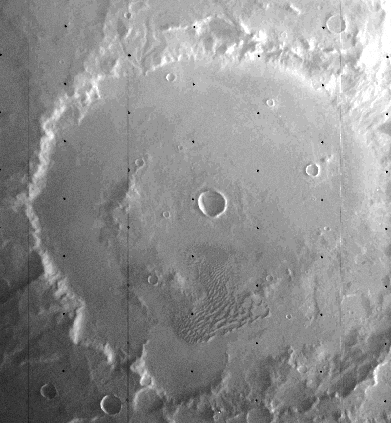
Figure 10 illustrates the size of Olympus Mons almost three times as high as Mauna Loa, Hawaii, measured from its Pacific Ocean base. [ 11 ] And the volcanic base of Olympus Mons is about 180 miles in diameter-about the distance from North Seattle to South Portland. Compared to Olympus, Mount Baker, Glacier Peak, Mount Ranier, Mount St. Helens, Mount Adams, and Mount Hood are six volcanic pimples.
There is no question that Olympus Mons suddenly erupted simultaneously with the uplifting of Tharsis. Its formation likely began within 90 minutes after Astra's fragmentation, within 60 minutes of Hellas' impact, and within 30 minutes of the internal pressure and shock waves reaching the Tharsis region.
Thus we find in the Opposite Hemisphere three kinds of relief from the Hellas asteroid impact. These are bulging and volcanism - both rapid responses to the need for relief. And there is also rifting, a slower response. In addition to the Tharsis Bulge opposite the Hellas impact, note is also taken of the Elysian Bulge opposite the Isidis impact area.
We suspect that a line drawn between each of the following features will point toward the fragmentation location, some 3000 miles in space near the Southern Hemisphere of Mars:
1. From subpoint at 319 degrees West and 45 degrees South to Mars' center.
2. From Olympus Mons to the center of Hellas Planitia.
3. From Arsia Mons to the center of Argyre Planitia.
4. From the Tharsis Bulge to Hellas Planitia.
5. From the Elysian Bulge to Isidis Planitia.
If this analysis is valid, then
further investigation should reveal that a difference exists in the steepness
of the walls of various craters, with the steeper side opposite the subpoint,
and the shallower side on the nearer side facing the subpoint.
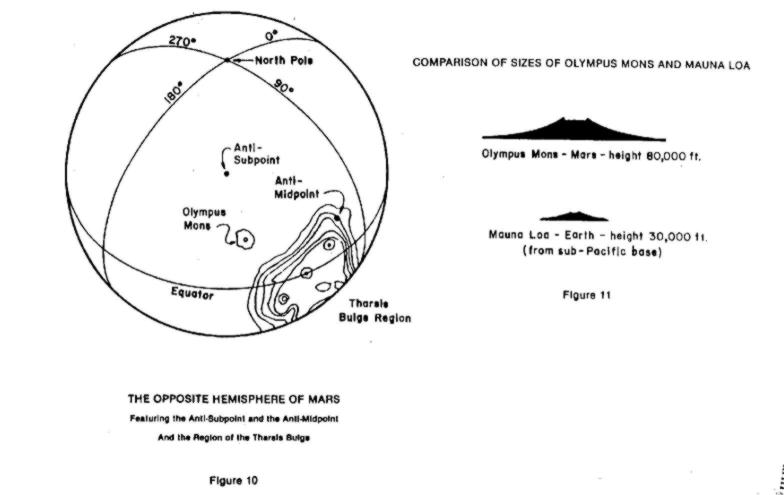
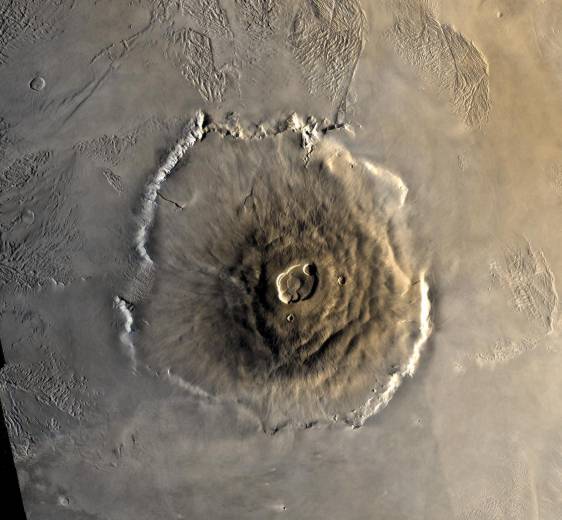
OLYMPUS MONS
IX. The Presence of Two Tiny Satellites

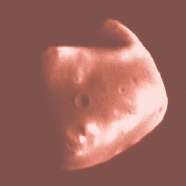
DEIMOS
Not only Mars has captured two asteroid-like satellites. Jupiter has directly captured another eight.[12] And in addition, Jupiter's immense gravity has so influenced the asteroids as to have gathered two clusters of them into parallel orbits. These are named the "Trojan" asteroids after mythology relating to Mars coming from Homer and the Trojan War, around 864 B.C.
The Trojans are about a dozen asteroids which have assumed two strange orbits in our solar system. One group is at 2/3 and the other is at 3/4 of the orbital period of Jupiter. For each group the positions of the Trojans in their orbits always make an equilateral triangle with the Sun and Jupiter being the other two points of the triangle.
How could little Mars capture two tiny asteroids when Jupiter, with its massive gravity, has managed to collect only six or eight? Jupiter's mass is about 3000 times greater than Mars' paltry mass and gravitational attraction. According to Richards: [13]
Phobos and Deimos are the same size as many of the asteroids. On the face
of it, such a hypothesis [evolutionary capture by chance of the two
trabants] sounds quite possible, but upon closer examination it does not
stand up so well. A planet only one-tenth as massive as Earth could not easily
effect a capture. Suppose that eight small satellites of Jupiter are captured asteroids.
Then Mars, with a mass only 1/2950 that of Jupiter, has done extraordinarily well to
have been able to latch onto two such bodies. The asteroids revolve in orbits that have
no particular relationship to the orbit of Mars.
Suppose one of the satellites is a captured asteroid, captured in such a way that it
revolves in a circular orbit in the plane of the planet's equator.... It does seem
incredible that Mars could have effected two such very special captures. Further
speculation along this line is useless.
Richards has correctly pointed out that tiny Mars could hardly grab a small asteroid moving about 6000 miles per hour on the fly. Any asteroid buzzing Mars would be well past it in the timespan of an hour or two and beyond any hope of capture.
Richards, however, has not considered the possibility that Mars in ancient times once had a different orbit, wherein it caused the fragmentation of Astra. In Figure 5 we have suggested that Deimos and Phobos were exploded backwards from Astra's trajectory. This had a tendency to cancel or neutralize the velocities of these two trabants or to brake them temporarily. Within our model the capture of these two bodies is not only possible but also the most probable explanation, effecting a capture along with some minor asteroidal debris.
Deimos and Phobos' pitlets, quite numerous on such small trabants, give testimony to the possibility of other, smaller debris also gathering in rings around Mars.[14] And perhaps, if Figure 1 validly portrays Mars' ancient orbit, later interactions with the Earth cleared away all of that debris except Deimos and Phobos.
X. Retrograde Direction of Mars' Moons
Figure 6 illustrates the capture of Deimos and Phobos. In order for these two bodies to be captured retrogradely, the geometry requires that Astra approach Mars from the sunward side. This suggests Astra was receding toward its aphelion whereas Mars was just past aphelion and beginning its long 720-day journey toward perihelion.
All planets in the solar
system revolve directly, which is counter-clockwise as viewed from Polaris.
Almost all of the satellites also revolve in direct motion. Only four of
the small asteroid-like moons of Jupiter, the two moons of Mars, and one
moon of Neptune revolve in retrograde motion.[15]
XI. Perihelions of the Largest Asteroids
If this fragmentation occurred around 205,000,000 or 210,000,000 miles from the Sun, then how did the asteroids come to arrive at regions considerably more distant? For instance, among the ten largest asteroids, the average perihelion distance is 240,000,000 miles.
There are two factors to consider in answering this question. First, Astra was apparently moving in its orbit away from the Sun when it was at the fatal scene. This motion was imparted to each of the fragments plus a variety of vectors added from the force of explosion. The exploding force would accelerate some fragments, retard others, and disperse yet others in sideward directions.
But also, if fragments nearly hit Mars�yet just missed, Mars' gravity would have acted upon them precisely as the massive gravities of Jupiter and Saturn acted on some recent spacecraft, which was to act as a booster. Thus three factors (at least) need to be examined in the trajectories of the current asteroids. These are:
1. The motion of Astra.
2. The direction, and level, of energy imparted by the
explosion.
3. The booster effect of the asteroids using Mars as
a turnpoint for a new orbit .
4. Finally, the subsequent influences of Jupiter and
Saturn, which necessarily come into effect.
These seem to be the motions or forces which have brought the variety of asteroids into their current orbits.
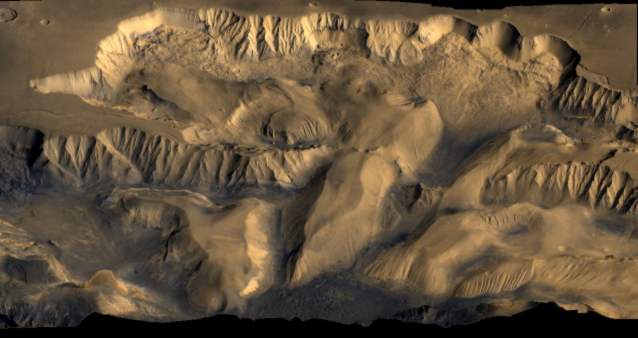
Conclusion
Some thirteen levels of evidence have been presented in support of this concept of Mars and the asteroids. Perhaps some day a young celestial mechanic will program the asteroid orbits on a computer and measure and adjust for the perturbing effects of Jupiter and Saturn. In such a scenario many asteroids could be traced back to one location some 205 to 210 million miles from the Sun. And they could be trailed back to one certain moment of time.
We suspect this fragmentation was a recent event in the solar system, and will be considered "ancient" only in terms of thousands not millions or billions of years .
Further, we suspect that such a location will be posited in the general region of 270 degrees from the Earth's autumnal node. This is the region directly overhead at midnight in mid- or late June.
An analysis of the physical
geography of both hemispheres of Mars has been made. Both hemispheres have
shown evidence for such massive fragmentation.
The Opposite Hemisphere contains such evidence as:
1. Bulging, with the Tharsis and Elysian bulges studied.
2. Volcanism, with Olympus Mons being the primary (but
not the only)
example.
3. Rifting, with the Valles Marineris and Noctis Labyrinthus as examples.
The Hemisphere of Craters contains such evidence as:
4. Possession of over 92 percent of all Martian craters 20 miles and larger in diameter.
5. Possession of a well defined hemisphere of' cratering.
6. Exhibition of many larger craters associated with numerous rim craters.
7. Exhibition of craters on an arcuate pattern, as judged from the subpoint.
In counting and measuring. the following were found to be commensurate:
8. The count of 20 mile (+) craters, like asteroids, of about 2700 to 2800.
9. The sizes of the largest impact asteroid craters relate to the asteroids.
The conclusion was made that fragmentation occurred some 3000 miles over and above the Southern Hemisphere of Mars, based on:
10. The location of the subpoint for the Hemisphere of Craters.
11. The trajectory line between Tharsis Bulge and Hellas Planitia.
12. The trajectory line between Arsis Mons and Argyre Planitia.
13. Roche's Limit, especially as redefined by Loren Steinauer.
Concerning Deimos and Phobos. we discussed:
14. The impossibility of capture on the fly, as adjudged by Richards.
15. The possibility of capture with other debris under fragmenting conditions.
16. The geometry of a capture in retrograde orbit.
Concerning the current asteroids, we discussed:
17. The booster effect given to their arriving at a new orbit.
18 The explosion effect on trajectories.
All of this data are circumstantial evidence that:
A. Mars caused the fragmentation of Astra into the current asteroids.
B. Mars caused the fragmentation of Astra into the impact asteroids.
C. Mars caused the fragmentation of Astra into the two trabants of Mars.
D. Mars caused the fragmentation of Astra into six or eight of Jupiter's tiny moons .
E. Mars formerly had a more eccentric orbit wherein its aphelion was in the zone of 210,000,000 miles from the Sun, also expressed as 2.25 a.u. [16]
Analysis of probable volumes of current asteroids and impact asteroids suggests that:
19. Astra was no smaller than 1250 miles in diameter and no larger than 1400 miles in diameter, and resembled Pluto in size.
20. Astra may well be the source for iridium enrichment on Mars' surface.
Once there were ten sisters
(planets) in the heavens These included four large ones - Jupiter,
Saturn, Uranus, Neptune (the Jovians) and six terrestrials Mercury, Venus,
Earth, Mars, Astra, Pluto. After this event there were but nine.
[17] Near-by Mars shows the scars.
Scattered asteroids do in fact
suggest much about the development of the solar system, but the traditional
concept of growing planetesimals as a basis for its origin should be scrapped
for models exhibiting catastrophism and capture. Deimos and Phobos could
be unique; on the other hand they just might be two of many examples of
a wide-ranging catastrophic cosmology.
REFERENCES
7. Moore and Hunt, 212, 213.
8. D. D. Bogard and P. Johnson, Martian Gases in
an Antarctic Meteorite?" Science, Vol. 221 August 12, 1983),651
Significant abundances
of trapped argon, krypton. and xenon have been measured in shock-altered
phases of the achondritic meteorite Elephant Moraine 79001 from Antarctica
. The relative elemental abundances, the high ratios of argon 40 to argon
36 (*2000), and the high ratios of xenon-129 to xenon-132 (*2.0) of the
trapped gas more closely resemble Viking data for the Martian atmosphere
than data for noble gas components typically found on meteorites. These
findings support earlier suggestions, made on the basis of gcoehemical
evidence that shergottites and related rare meteorites may have originated
from the planet Mars.
9. Moore and Htunt, 226
10. Moore and Hunt, 226
11. The volcanic base of Olympus Mons is 180 miles in diameter and covers more than 25,000 square miles. The caldera (cone) is 50 miles wide. The rim of the caldera is estimated to be 13 miles high above the surrounding plain.
12. Elara, Himalia, Lysithea, and Leda all revolve retrogradely, as do Deimos and Phobos, and are commonly presumed to be captured asteroids. Carme, Ananke, Sinope and Pasiphe all revolve directly (like the planets) and may also be captured asteroids. The largest is Himalia (diameter 105 miles) Others have diameters ranging between 50 miles (Elara) and 4 miles (Leda).
13. Robert S. Richards,Mers New York: Hareourt, Brace 1964, 93
14. Over the past three centuries rings around a
planet have been considered a rarity and an anomaly. Saturn (1) with its
shining, icy rings was the sole example. Within the last decade a thin
ring, composed of dark, rock-like material, has been discovered at Roche's
Limit for
Jupiter 12). And even more recently a similar thin, dark
ring has been found around Uranus (3). Neptune is too distant to see a
ring system like that of Uranus, but many expect such a phenomenon there.
Based on Diemos and Phobos' pitlets, we suspect that Mars (4) temporarily had a ring of asteroid-like debris. Astra's fragmentation is estimated at 5793 miles from Mars' center. Phobos at 5760 miles is in the region of Roche's Limit. It may well be that Phobos is the only remnant of that temporary ring. Deimos at 14,540 miles was perhaps captured independently of Phobos.
Moreover, if the Mars-Frosty system interacted with the Earth-Moon System subsequently, and Frosty fragmented, (deluging both planets with ice fragments), many of the frozen particles would temporarily assume orbits around Earth. There they would be exposed to solar radiation and geomagnetic forces, ice being a dielectric substance. A massive deposition of ice in the region of Farth's magnetic polar regions, and/or the vortices of the radiation belts (containing the makings of an ice age), could be interpreted as evidence that (5) the Earth also temporarily had a ring system, composed of ice like Saturn's, rather than rock like Jupiter's and Uranus'.
With Neptune and Pluto too distant for decisive conclusions, this leaves only Mercury, Venus, and Astra as planets not having rings. And Astra became temporary ring matter in part, satellites of Jupiter and Mars in part, as well as current asteroids and impact asteroids. Perhaps Mercury and Venus are the exceptions rather than Saturn, as assumed in conventional astronomy for three centuries.
15. Richards, 93.
Suppose one of the satellites
is a captured asteroid, caught in such a way that it revolves in a circular
orbit in the plane of the planet's equator. It does seem incredible that
Mars could have effected two such very special captures. "Further speculation
along this line is useless"!
We note, concerning Richards' conclusion, that twenty years ago the uselessness of further enquiry may well have been greeted without objection. More information, however, is now available-and catastrophic evidence is in wide array. Some space research personnel receive the nebular hypothesis cosmology with reservations and objections rather than acceptance. It is no longer necessary-or logical-to accept Richards' resignation on the origin of the Martian satellites.
16. One astronomical unit is 92,900,000 miles, the average distance of the Earth from the Sun. The region of 210,000,000 miles from the Sun, suspected to be the region of Mars' ancient aphelion, is about 2.25 a.u. Mars' current aphelion is about 1.6 a.u.
17. Astra must have had many near fly-bys with Mars prior to the fatal one. This paper merely covers the climax of that series, and it could have been entitled "Star Wars" rather than 'The Scars of Mars " Had there been one or more encounters later between the Mars-Frosty system and the Earth-Moon system, this paper would only have addressed one such climax�"Star Wars 1," as it were.
DONALD W. PATTEN born in Montana is a veteran of the Korean
War. He received both B.A. and M.A. degrees in geography from the Umversity
of Washington. He is the author of The Biblical Flood and the Ice Epoch
(1977) and the Long Day of Joshua and Six Other Catastrophes (1973) as
well as editor of the Symposium on Creation series. He lives in Seattle
Washington.
Webpage http://www.eskimo.com/~dwpatten/
e-mail dwpatten@eskimo.com
Articles from Catastrophism And Ancient History
are brought to you by The Thule Foundation